Home
Categories
Dictionary
Glossary
Download
Project Details
Changes Log
What Links Here
FAQ
License
Map ontology FillOntology module
1 Overview
2 Ontology model
2.1 Elements geometry
2.2 Aircraft
2.3 Alarm
2.4 Flightplan
2.5 Waypoint
3 Specify the Jena model mapping
3.1 Aircraft, Flightplan, and Waypoints mapping
3.2 Alerts mapping
3.3 Complete mapping declaration
4 Create the FillOntology module
4.1 Specify the module interfaces
4.2 Module initialization
4.3 Handle the service notifications
4.4 Waypoints and Flightplans notification
4.5 Aircrafts notification
4.6 Alerts notification
5 Notes
6 See also
2 Ontology model
2.1 Elements geometry
2.2 Aircraft
2.3 Alarm
2.4 Flightplan
2.5 Waypoint
3 Specify the Jena model mapping
3.1 Aircraft, Flightplan, and Waypoints mapping
3.2 Alerts mapping
3.3 Complete mapping declaration
4 Create the FillOntology module
4.1 Specify the module interfaces
4.2 Module initialization
4.3 Handle the service notifications
4.4 Waypoints and Flightplans notification
4.5 Aircrafts notification
4.6 Alerts notification
5 Notes
6 See also
This article presents the fillOntology module used in the map ontology tutorial.
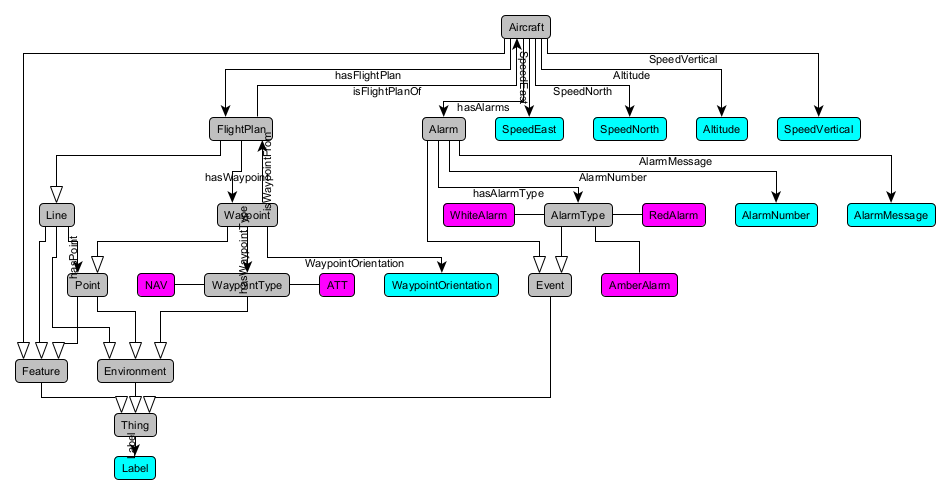
This ontology has the following elements:
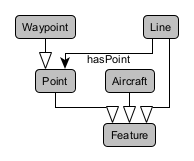
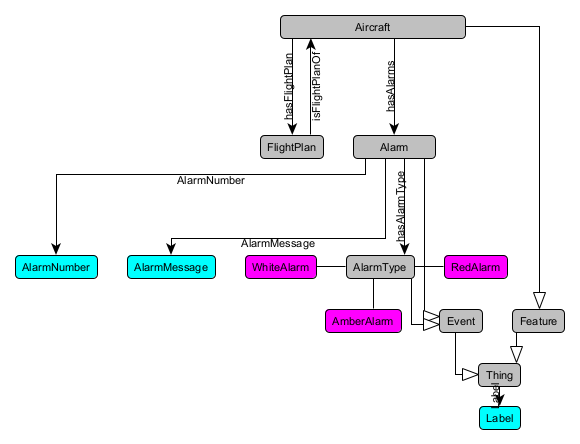
The
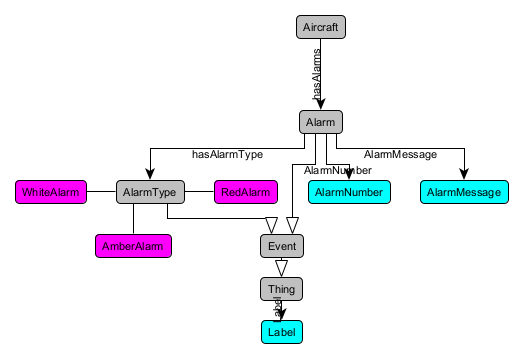
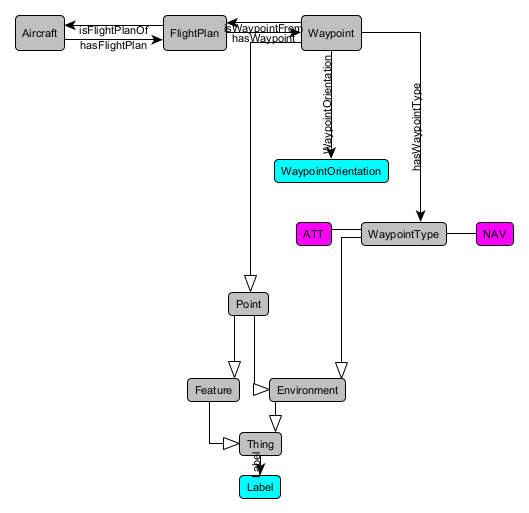
The

For the Aircraft:

As there is no class for the Alerts, we will not be able to define a Java class mapping. The mapping will be:
We will create an Object mapping during our module initialization using our mapping XML specification:
Overview
The fillOntology module is responsible to:- Fill the Ontology with the flightplan, and the waypoints
- Fill and update the Ontology with the aircraft position
- Update the Ontology depending on the notification of the
alertservice
Ontology model
We will use the following ontology:
This ontology has the following elements:
-
Aircraft: the aircraft -
FlightPlan: the FlightPlan, which contains Waypoints -
Waypoint: the Waypoints -
Alarm: the Alarms
Elements geometry
The following elements are subclasses of the GeosparqlFeature class, because they have a geometrical position:-
Aircraft: the aircraft -
Waypoint: the Waypoints

Aircraft
TheAircraft has:- A
Label - A
Geometry(theAircraftis a subclass ofFeature), which in this case specify the latitude and longitude of the Aircraft - One
FlightPlanthat the Aircraft follows - One or several
Alarms

The
Aircraft refer to a Aircraft in the tacticalEnv model.
Alarm
AnAlarm has:- An
AlarmNumber: the number of the Alarm - An
AlarmMessage: the message of the Alarm - A link to an
AlarmType(WhiteAlarm,AmberAlarm, orRedAlarm). The AlarmType represents the danger of the Alarm

Flightplan
AnFlightPlan has:- A
Label, which is the name of the FlightPlan - Links to the list of Waypoints which define the FlightPlan
FlightPlan refer to a FlightPlan in the tacticalEnv model.
Waypoint
AWaypoint has:- A
Label, which is the name of the Waypoint - A
Geometry(theWaypointis a subclass ofFeature), which in this case specify the latitude and longitude of the Waypoint - A link to a
WaypointType(NAVorATT). NAV are navigation points (used for example to define the FlightPlan), and ATT are landing waypoints

The
Waypoint refer to a Waypoint in the tacticalEnv model.
Specify the Jena model mapping
We want to bridge our ontology to the tacticalEnv model:- The Aircraft concept in the tacticalEnv model to the
Aircraftclass in the Ontology - The Waypoint concept in the tacticalEnv model to the
Waypointclass in the Ontology - The alert received through the
alertservice to theAlarmclass in the Ontology
Aircraft and the Waypoint will directly come from Java classes, whereas the Alarm will have to be constructed from the content of a service. The mappings will be specified through a Jena model mapping.
Aircraft, Flightplan, and Waypoints mapping
These notions will be mapped to Java classes, becasue all three notions correspond to a class in the tacticalenvModel.
For the Aircraft:
- The name of the Aircraft will be mapped to the
LabelDataProperty on theThingclass - The position of the Aircraft will be mapped to the geometry on the
Aircraftclass
<classTypes> <class path="org.da.protoframework.tacticalenv.common.model.Aircraft" nameMethod="getName"> <type object="track" /> </class> </classTypes> <object name="track" className="Aircraft"> <geometry /> <dataProperty name="label" property="Label" isName="true"/> </object>For the Waypoint:
- The name of the Waypoint will be mapped to the
LabelDataProperty on theThingclass - The position of the Waypoint will be mapped to the geometry on the
Waypointclass - The type of the Waypoint will be mapped to the
hasWaypointTypeproperty on theWaypointclass. As there is only one Waypoint type of course, this mapping will have a cardinality ofone - The Flightplan of the Waypoint will be mapped to the
isWaypointFromproperty on theWaypointclass. As there is only one Flightplan for one Waypoint in our case, this mapping will have a cardinality ofone
<classTypes> <class path="org.da.protoframework.tacticalenv.common.model.Waypoint" nameMethod="getName"> <type object="waypoint" /> </class> </classTypes> <object name="waypoint" className="Waypoint"> <geometry /> <dataProperty name="label" property="Label" isName="true"/> <property name="hasWaypointType" eltRef="WaypointType" property="hasWaypointType" cardinality="one" /> <property name="isWaypointFrom" eltRef="flightplan" property="isWaypointFrom" cardinality="one" /> </object>For the FlightPlan:
- The name of the FlightPlan will be mapped to the
LabelDataProperty on theThingclass - The list of Waypoints in the Flightplan will be mapped to the
hasWaypointproperty on theFlightplanclass. As there are as many Waypoints per one Flightplan, this mapping will have a cardinality ofunbound
<classTypes> <class path="org.da.protoframework.tacticalenv.common.model.Flightplan" nameMethod="getName"> <type object="flightplan" /> </class> </classTypes> <object name="flightplan" className="FlightPlan"> <dataProperty name="label" property="Label" isName="true"/> <property name="waypoint" eltRef="waypoint" property="hasWaypoint" inverseProperty="isWaypointFrom" cardinality="unbound" inverseCardinality="one" /> </object>
Alerts mapping

As there is no class for the Alerts, we will not be able to define a Java class mapping. The mapping will be:
<object name="alarm" className="Alarm"> <dataProperty name="number" property="AlarmNumber"/> <dataProperty name="message" property="AlarmMessage"/> <property name="type" eltRef="alarmType" property="hasAlarmType" cardinality="one" /> </object>
Complete mapping declaration
The complete mapping declaration is: objectMappings.xmlCreate the FillOntology module
To fill the Ontology, we must:- Use the mapping declaration to create the Jena operations
- Update the Ontology for each service notification
- Fill the Ontology with the flightplan, and the waypoints
- Fill and update the Ontology with the aircraft position
- Update the Ontology depending on the notification of the
alertservice
Specify the module interfaces
The fillOntology module has the following module configuration:<application name="fillOntology"> <deployment> <lib url="FillOntology.jar" /> </deployment> <modules> <module name="fillOntology"> <implementation path="org.da.owl.FillOntology" > <initEntryPoint method="init" /> <defaultReceiveEntryPoint method="subscribe" /> </implementation> <interfaces> <eventReceived service="alert" /> <eventReceived service="flightplansModel" uri="http://dassault-aviation.com/tacticalenv"/> <eventReceived service="waypointsModel" uri="http://dassault-aviation.com/tacticalenv"/> <subscribe service="aircraftsModel" uri="http://dassault-aviation.com/tacticalenv"/> <requestSend service="applyOperations" uri="http://dassault-aviation.com/jena" /> </interfaces> </module> </modules> </application>It will be notified from the following services:
- The
flightplansModelandwaypointsModelservices to set the flightplan and the Waypoints - The
aircraftsModelservice to update the position of the Aircraft - The
alertservice to receive the alerting status
applyOperations service[1]
See Jena applyOperations service for more information about this service
to update the Ontology.
Module initialization
Main Article: creating and using a batch of creations and updates
We will create an Object mapping during our module initialization using our mapping XML specification:
public void init(Module module) { mappings = new ObjectMappings(); URL url = this.getClass().getResource("objectMappings.xml"); mappings.parse(module, url, true); // here we create operations for the Waypoints and the Flightplan, the Aircraft, and the Alerts wptOp = new ElementsOperations(module, mappings); acOp = new ElementsOperations(module, mappings); alertOp = new ElementsOperations(module, mappings); }
Handle the service notifications
The following code will handle the notification from theflightplansModel, waypointsModel, aircraftsModel, and alert services.public synchronized void subscribe(ServiceInstance service) { NamespaceKey key = service.getKey(); if (key.equals(ENV_WAYPOINTS)) { this.waypointsReceived = true; if (flightplansReceived) { receiveWaypointsAndFlightPlans(service); } } else if (key.equals(ENV_FLIGHTPLANS)) { this.flightplansReceived = true; if (waypointsReceived) { receiveWaypointsAndFlightPlans(service); } } else if (key.equals(ENV_AIRCRAFTS)) { if (waypointsReceived && flightplansReceived) { receiveAircrafts(service); } } else if (service.getName().equals("alert")) { receiveAlert(service); } }As you can see, we will update the Ontology with the content of both the Waypoints and the Flightplan when both the tacticalEnv model
flightplansModel and waypointsModel have been notified.
Waypoints and Flightplans notification
The following method update the Ontology with the Flightplans and Waypoints definition:private void receiveWaypointsAndFlightPlans(ServiceInstance service) { // waypoints Waypoints waypoints = (Waypoints) envWaypointsService.getDataValue("waypoints"); Iterator<Waypoint> it = waypoints.getWaypoints().values().iterator(); while (it.hasNext()) { Waypoint waypoint = it.next(); // this method will ensure that the Waypoint individual will be created // we don't need to set the Label of the Waypoint, because it is already taken care of in the mappings MappedElement elt = wptOp.addElement(waypoint); float latitude = waypoint.getLatitude(); float longitude = waypoint.getLongitude(); // will create the geometry of the Waypoint individual in the Ontology elt.setPosition(latitude, longitude); // specifies the hasWaypointType property, which links to the appropriate WaypointType element String type = waypoint.getType(); if (type.equals("NAV")) { elt.addProperty("hasWaypointType", "NAV"); } else if (type.equals("ATT")) { elt.addProperty("hasWaypointType", "ATT"); } } // flightplans Flightplans flightplans = (Flightplans) envFlightplansService.getDataValue("flightplans"); Iterator<Flightplan> it2 = flightplans.getFlightplans().values().iterator(); while (it2.hasNext()) { Flightplan fp = it2.next(); // this method will ensure that the Flightplan individual will be created // we don't need to set the Label of the Flightplan, because it is already taken care of in the mappings MappedElement flightplanElt = wptOp.addElement(fp); Iterator<String> it3 = fp.getWaypoints().iterator(); while (it3.hasNext()) { String name = it3.next(); // specifies a hasWaypoint property, which links to one Waypoint individual flightplanElt.addProperty("waypoint", name); } } // handle the creation of the operations. All the effective Ontology update will be done in the Jena Module Operations operations = wptOp.create(); applyOperations.setDataValue("operations", operations); applyOperations.invoke(); }As they will only be received once, we only create the indivduals in the Ontology. We don't need to update their position because the position of the Flightplan and the Waypoints won't be updated.
Aircrafts notification
The following method update the Ontology with the Aircrafts definition:private void receiveAircrafts(ServiceInstance service) { applyOperations.setDataStringValue("reqSchema", SCHEMA); Aircrafts envAircrafts = (Aircrafts) service.getValue("aircrafts"); Iterator<Aircraft> it = envAircrafts.getAircrafts().values().iterator(); while (it.hasNext()) { Aircraft aircraft = it.next(); if (aircraft.getName().equals("falcon")) { float latitude = aircraft.getLatitude(); float longitude = aircraft.getLongitude(); // this method will ensure that the Aircraft individual will be created // we don't need to set the Label of the Aircraft, because it is already taken care of in the mappings MappedElement elt = acOp.addElement(aircraft); if (!acReceived) { // will create the geometry of the Aircraft individual in the Ontology elt.setPosition(latitude, longitude); } else { // will update the geometry of the Aircraft individual in the Ontology acOp.updateElementPosition("track", aircraft.getName(), latitude, longitude); } } } // handle the creation of the operations. All the effective Ontology update will be done in the Jena Module Operations operations = acOp.create(); acOp.clearOperations(); applyOperations.setDataValue("operations", operations); applyOperations.invoke(); acReceived = true; }We will create the
falcon Aircraft for the first notification, then for further notifications we will just update the existing Individual position.
Alerts notification
Alerts do not correspond to a Java clas, so we need in this case to handle the fields directly. Thealert service contains the alert itself and its status:<event name="alert"> <data name="alert" type="alert" desc="the alert"/> <data name="status" type="alertStatus" desc="the alert status"/> </event>The associated types are:
<enumType name="alertType" > <enumValue name="WARNING" /> <enumValue name="CAUTION" /> <enumValue name="ADVISORY" /> </enumType> <enumType name="alertStatus" > <enumValue name="NEW" /> <enumValue name="REMOVED" /> </enumType> <structType name="alert"> <field name="number" type="int" /> <field name="type" type="alertType" /> <field name="content" type="string" /> </structType>We will use the Alert
number, type, and status:- The
numberfield specifies the name of theAlarmindividual to create or remove - The
typefield specifies theAlarmTypeindividual on which we must link to - The
statusdata specifies if we need to create the individual or remove an existing one
private void receiveAlert(ServiceInstance service) { List<Object> alertObj = service.getData("alert").getValueAsStructure(); int number = alertType.getFieldValueAsInt("number", alertObj); String alarmType = alertType.getFieldValueAsString("type", alertObj); int status = service.getData("status").getValueAsInt(); applyOperations.setDataStringValue("reqSchema", SCHEMA); // create an alarm MappedElement elt = alertOp.addElement("alarm", "alarm" + number); // add the AlarmNumber dataProperty elt.addDataProperty("number", number); // specifies the hasAlarmType property, which links to the appropriate AlarmType element switch (alarmType) { case "WARNING": elt.addProperty("type", "RedAlarm"); break; case "CAUTION": elt.addProperty("type", "AmberAlarm"); break; case "ADVISORY": elt.addProperty("type", "WhiteAlarm"); break; } // if status == 1 the Alarm was removed from the Alarm list if (status == 1) { // in this case, the existing Alarm element will be deleted from the Ontology rather than created elt.setRemoved(true); } // handle the creation of the operations. All the effective Ontology update will be done in the Jena Module Operations operations = alertOp.create(); alertOp.clearOperations(); applyOperations.setDataValue("operations", operations); applyOperations.invoke(); }
Notes
- ^ See Jena applyOperations service for more information about this service
See also
- Map ontology tutorial: The synthetic map tutorial present the usage of a tacticalEnv Application associated with an Ontology allowing to ask requests
- Jena module: The Jena application allows the user to invoke the Apache Jena ontology framework
×
![]()
Categories: tutorials